Exploring Hydraulic Circuits on Excavators for Attachment Operations
Excavators are indispensable heavy machinery in construction, mining, and various other industries. They owe their incredible versatility in large part to their hydraulic systems, which power a multitude of attachments for diverse tasks. Hydraulic circuits on excavators are designed to provide precise control, flow, and pressure to these attachments. In this comprehensive article, we will delve into the various types of hydraulic circuits used to run attachments on excavators, including the primary circuits and auxiliary circuits.
While skid steers are very similar, this article is going to focus specifically on excavator setups.

Primary Hydraulic Circuits
Firstly, let’s quickly cover the primary hydraulic circuits that are on every excavator – large and small. Every moving function of the excavator like the bucket curl, boom angle, slewing left and right, all require hydraulic power. In this article, we will refer to these as the primary hydraulic circuits. Every machine no matter how old or new will have a hydraulic circuit enabling each of the functions listed below.
Bucket Circuit

The bucket circuit is the one of the main primary hydraulic circuits on the machine. It controls the movement of the bucket itself. It consists of a pump, control valve, hydraulic cylinder, and associated hoses. The flow and pressure in this circuit are carefully regulated to ensure smooth digging and material handling as well as optimizing breakout force.
Boom Circuit

The boom circuit controls the upward and downward movement of the boom, allowing the operator to reach different heights and depths. This circuit is essential for excavation and lifting tasks. It usually consists of 2 hydraulic cylinders (depending on the size of the machine), hoses, and a control valve that regulates flow and pressure.
Dipper Arm Circuit
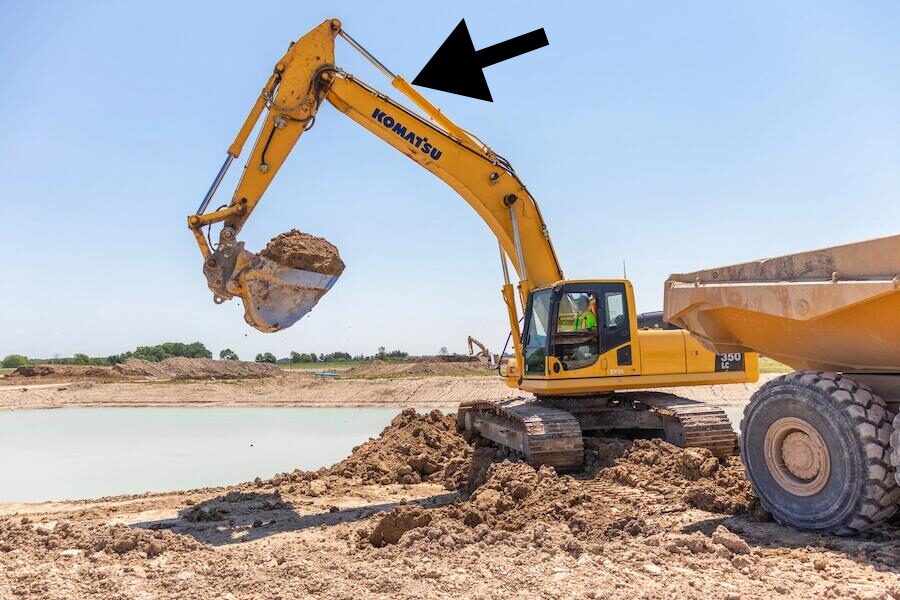
The dipper arm circuit controls the extension and retraction of the arm/stick, providing precise control over the digging depth. It typically consists of a hydraulic cylinder, hoses, and a control valve. This cylinder is usually located on top of the boom of the machine.
Slewing/Swing Circuit: The slewing circuit is responsible for rotating the upper structure of the excavator. It allows the operator to position the excavator accurately. This circuit comprises a hydraulic motor, slewing ring, hoses, and a control valve. This allows endless 360 degree rotation of the excavator.
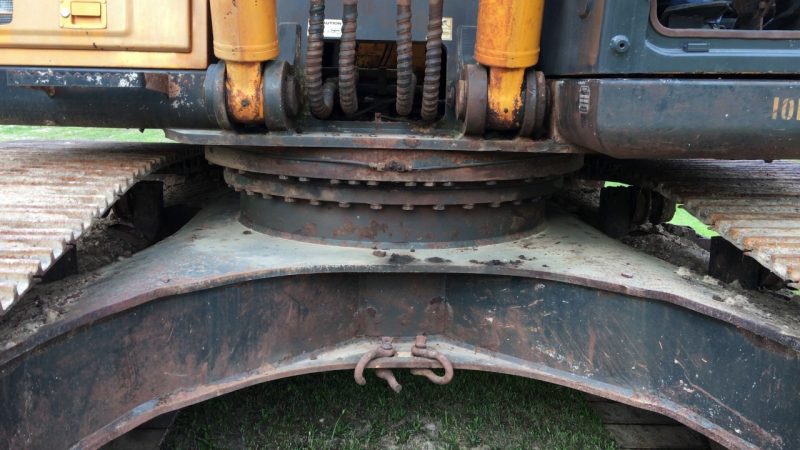
Auxiliary Hydraulic Circuits
In addition to the primary circuits, excavators can be equipped with auxiliary hydraulic circuits that enable them to power various attachments. These auxiliary circuits offer versatility and expand the excavator’s capabilities. Just by looking at the machine you can see how many auxiliary circuits it has equipped by looking on the side of the dipper arm/stick. Every circuit is of course going to have 2 hoses, so each set of 2 hoses is one hydraulic circuit.
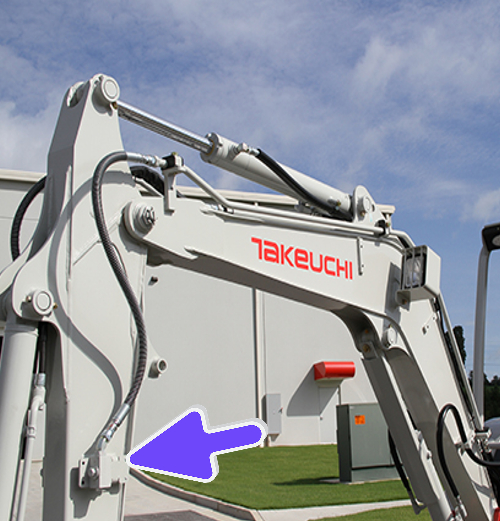
Here are the primary types of auxiliary hydraulic circuits:
Single-Acting Circuit: A single-acting circuit provides hydraulic flow in 1 direction only. This is ideal to operate attachments that require hydraulic force in one direction only, such as hydraulic breakers and post drivers. This circuit can often be referred to as a “breaker circuit”. Not many newer machines are fitted with a single acting hydraulic circuit, but older backhoes can be equipped with a single acting circuit only.
Double-Acting Circuit: Double-acting circuits are more versatile and can be used with attachments that require hydraulic flow in both directions, such as hydraulic thumbs, grapples, and augers. Think of any attachment that requires 2 movements like open/close, rotate clockwise/anti clockwise – as always needing 2 way flow. Every primary circuit on the machine that we touched on early has double acting flow – to open and close the hydraulic cylinders or slew the machine clockwise or counterclockwise.
Note: most double acting circuits can be manually set into single acting mode via a valve block on the machine. This is to use attachments like breakers safely in single acting mode.
Coupler Circuit:
Coupler circuits are a hydraulic circuit that can be added to machines to operate quick couplers. Couplers let the operator drop off and pick up different attachments without having to leave the machine. Most couplers operate using a hydraulic cylinder to open and close the coupler. They then have a locking mechanism to ensure the attachment can’t fall off in a dangerous position.
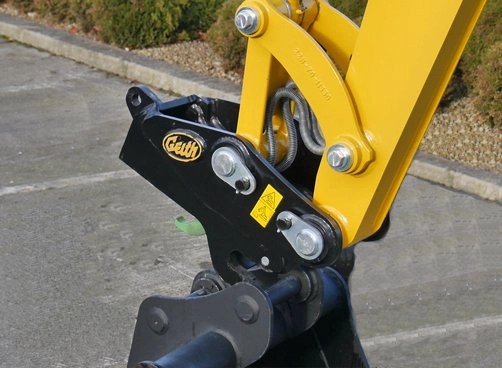
Coupler circuits are plumbed slightly differently as they often tap into another circuit of the machine to use its hydraulic flow & pressure. This means that they can be easily added to the machine if it is not equipped from the factory. Most couplers will come with a hydraulic kit to be installed on the machine to operate the coupler. When looking at a machine the coupler circuit usually has smaller hoses as it doesn’t require the same level of oil flow as other circuits. They are also usually located on top of the stick shown below:
One of the most common mistakes we come across is customers who mistake their auxiliary circuit for a coupler circuit. Because their machine has hydraulics on the stick, they think they can just use that for their coupler. As mentioned above, coupler circuits are plumbed differently, also for safety reasons. They require a solenoid block and control box in the cab in order to only open when the bucket is in the closed position so that the bucket or attachment doesn’t fall off.
You can find installation instructions for the Geith Hydraulic Coupler on our website here.
Adding An Auxiliary Circuit
Adding an auxiliary circuit to an excavator is a lot more complex than adding a coupler circuit. An auxiliary circuit requires a spare OEM valve on the machine’s pump(s) for the hydraulic pressure & flow but also an added method of operating in the cab, like a foot pedal or new joystick/roller.
There are companies that supply and install auxiliary hydraulic circuits on excavators, if you are looking to add one to your machine. However, this will be expensive and we would only recommend doing so if it is going to get a lot of use on the machine. If the excavator is going to be used on demolition jobs with a demolition grapple – then it might be worth adding a circuit to use the grab properly.
Attachments The Require More Than 1 Auxiliary Circuit
There are several attachments for excavators that require more than 1 auxiliary hydraulic circuit. These include: tiltrotators, rotating grabs/grapples, rotating shears, some mulchers etc.

All of these attachments have two or more functions and in turn can require a hydraulic circuit for each function. As you can see in the picture above, this machine has 2 sets of hydraulic hoses on each side of the stick that are connected to the grab attachment. One circuit opens and closes the grab while the other powers the rotation of the grab. Two separate circuits let the operator rotate and open/close the grab at the same time – unlike a diverter valve setup that we will discuss below.
With that being said, tiltrotators can be equipped with control systems that do all the work in separating the hydraulic flow from a single circuit.
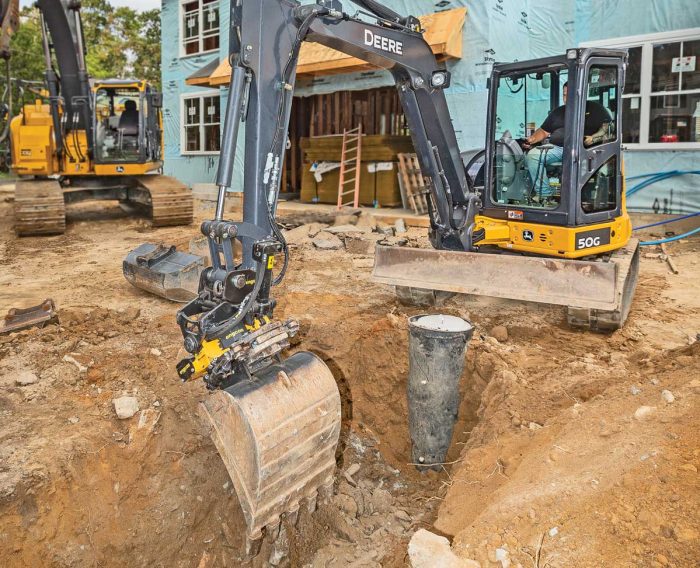
Adding a Second Function Using a Diverter Valve
If you have an attachment like a rotating grapple that requires two circuits to operate properly, but your machine only has 1 circuit, then there is another option. You can utilize a diverter valve to split up an existing double acting circuit. Most machines in the US are going to come from the factory with 1 double acting circuit and most machines will have a hydraulic thumb connected to this circuit.
A viable option in this instance is a diverter kit to let the operator switch the oil flow from that circuit to a second set of hoses to go to the attachment’s second function. This solenoid valve is often operated by a button or pedal that is installed in the cab. This, however, does mean that only one function can be performed at a time. For this grapple example, you won’t be able to rotate and open/close the grab simultaneously. This may be slightly awkward as an operator to have to continuously switch functions.

Above is an example of a kit that is manually changed by the operator by a valve that is located at the bottom of the boom. This would be the cheapest option for adding an extra circuit to your machine for running attachments. A kit like this would be more suited to an application that doesn’t require regular switching of functions.
There are also suppliers that offer an electrical version that is controlled by a button or pedal in the cab for fasting switching between the two circuits. This is much more suited for a grapple attachment that requires many switches between open/close & rotation functions.
Both of these setups will be much more affordable than adding a full new auxiliary circuit to the excavator.
Case Drains
A case drain is a hydraulic line that runs from the attachment back to the hydraulic tank of the excavator. Case drains relieve any excess pressure and drain it back to the tank. Many hydraulic motors require a case drain line to protect the motor/attachment. These are most commonly found on attachments like flails, mulchers and brush cutters that utilize high power hydraulic motors with pistons or gears.
A lot of excavators are not going to be equipped with a case drain from the factory but they are simple to install as they are just lines that run back to the hydraulic tank. Many machines even have spare access caps on the tanks to connect your line. If not, the tank might require drilling to install a hydraulic fitting to connect the line to.
It’s important to keep this in mind when purchasing a new attachment as it often is an added expense when installing your attachment. The attachment seller should list whether the attachment requires a case drain on their product listing.
Selecting the Correct Circuit for Your Attachment (or vice versa)
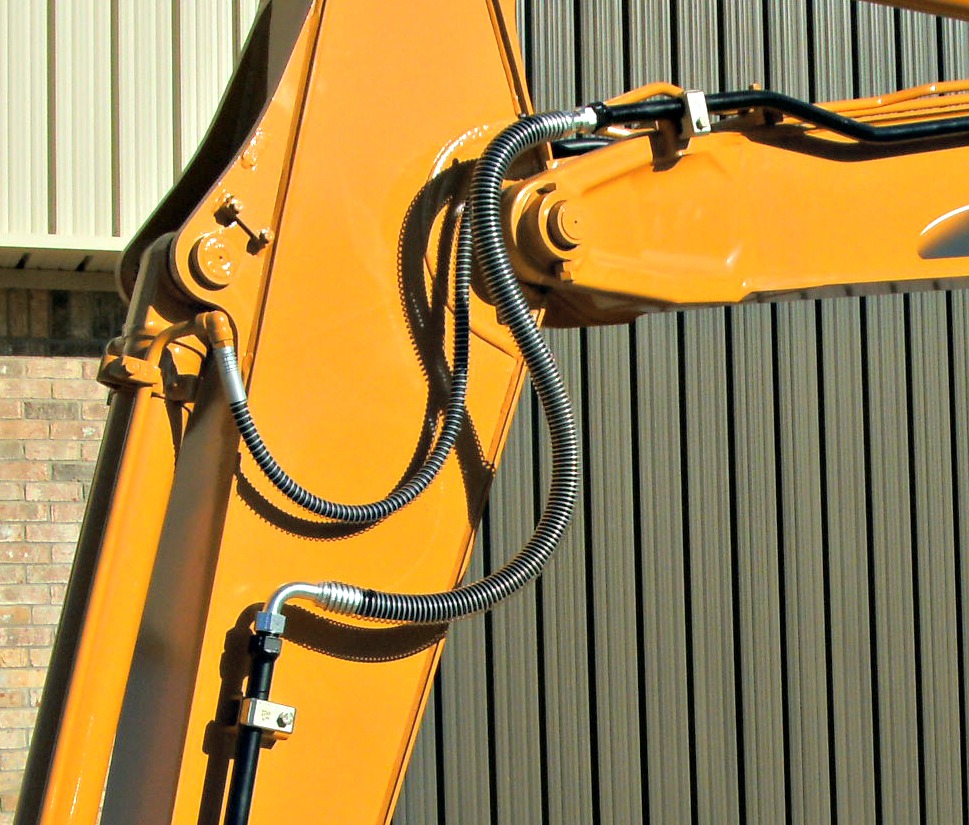
Choosing the appropriate hydraulic circuit to add to your machine for your attachment depends on the attachment’s specific requirements and the tasks you intend to perform. Consider factors such as flow rate, pressure rating, and the attachment’s compatibility with the excavator’s hydraulic system.
Adding hydraulic circuits to a machine can be expensive, so it’s important when purchasing a new or used machine, that it has the hydraulic capabilities that you need to run the attachments that you require for your applications.
In addition, a brief knowledge of the hydraulic circuits on your excavator will help you choose the correct hydraulic attachments for your machine. Hopefully this will prevent you from purchasing an attachment that isn’t compatible with the excavator’s hydraulics.
Conclusion
Hydraulic circuits are the lifeblood of excavators, enabling them to perform a wide range of tasks through various attachments. Understanding the different types of hydraulic circuits, both primary and auxiliary, is essential for maximizing the excavator’s versatility and productivity. Proper selection of hydraulic circuits on the excavator means that you can use the correct attachments on the job site and make your machine a much more valuable asset.
Hopefully this article was helpful in explaining the details of the excavator auxiliary hydraulic circuits needed for operating attachments. If you have any additional questions that we haven’t covered, please feel free to get in touch with us via the website, email or phone.
The Attachment Company LLC
(941) 212 0037
Resources
Sources for hydraulic kits:
Hydraulic Fittings Thread Chart

Hi, found your website while searching for info on Aux Lines.
We have a Bobcat 320 Excavator (~2001). It has 2 Aux Lines on the Dipper Arm. I hope to fit a Hydraulic Thumb: I’m being told they need to be “double-acting”. I’m trying to find out how I can confirm this…..
Much appreciated.